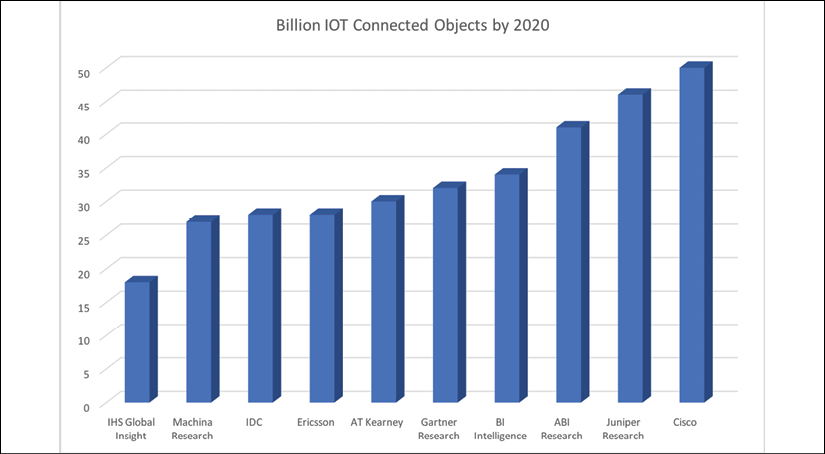IoT potential
The IoT is already affecting every segment in industrial, enterprise, health, and consumer products. It is important to understand the impact, as well as why these disparate industries will be forced to change in the ways they build products and provide services. Perhaps your role as an architect forces you to focus on one particular segment; however, it is helpful to understand the overlap with other use cases.
As previously mentioned, there is an opinion that the impact of IoT-related industries, services, and trade will affect 3 percent (The route to a trillion devices, ARM Ltd 2017) to 4 percent (The Internet of Things: Mapping Value Beyond the Hype, McKinsey and Company 2015) of global GDP by 2020 (extrapolated). Global GDP for 2016 was $75.64 trillion dollars, with an estimate that by 2020 it will rise to $81.5 trillion. That provides a range of value from IoT solutions of $2.4 trillion to about $4.9 trillion.
The scale of connected objects is unprecedented. Speculation of industry growth is imperiled with risks. To help normalize the impact, we look at several research firms and reports on the number of connected objects. The range is large, but still in the same order of magnitude. The average of these 10 analyst forecasts is about 33.4 billion connected things by 2020-2021. ARM recently conducted a study and forecast that by 2035 one trillion connected devices will be operational. By all accounts, the IoT deployment growth rate in the near term is about 20 percent year over year.

Figure 2: Analysts and industry claims of the number of connected objects
These numbers should at first glance impress the reader. For example, if we took a very conservative stance and predicted that only 20 billion newly connected devices would be deployed (excluding the traditional computing and mobile products), we would be saying that 211 new Internet-connected objects will come online every second.
Why this is of significance to the technology industry and IT sector is the fact that world population currently has a growth rate of roughly 0.9 percent to 1.09 percent per year (https://esa.un.org/unpd/wpp/). World population growth rate peaked in 1962 at 2.6 percent year over year and has steadily been declining due to a number of factors. First and foremost, improvement in world GDP and economies has a propensity to reduce birth rates. Other factors include wars and famine. That growth implies that human-connected objects will plateau, and machine to machine (M2M) and connected objects will represent the majority of devices connected to the Internet. This is important because the IT industry applies value to a network not necessarily by how much data is consumed, but by how many connections there are. This, generally speaking, is Metcalfe's law, and we will talk about that later in this book. It is also worth noting that after the first public website went live at CERN in 1990, it then took 15 additional years for 1 billion people to be regular users of the Internet. IoT is looking to add 6 billion connected devices per year. This, of course, is swaying the industry.

Figure 3: The disparity between human population growth versus connected thing growth. The trend has been a 20 percent growth of connected objects versus a nearly flat 0.9 percent human growth. Humans will no longer drive network and IT capacity.
It should be noted that economic impact is not solely revenue generation. The impact from IoT or any technology comes in the form of:
- New revenue streams (for example, green energy solutions)
- Reducing costs (for example, in-home patient healthcare)
- Reducing time to market (for example, factory automation)
- Improving supply chain logistics (for example, asset tracking)
- Reducing production loss (for example, theft or spoilage of perishables)
- Increasing productivity (for example, machine learning and data analytics)
- Cannibalization (for example, Nest replacing traditional thermostats)
In our discussion throughout this book, it should be at the top of our minds as to what value an IoT solution delivers. If it is simply a new gadget, there will be a limited market scope. Only when the foreseeable benefit outweighs the cost will an industry thrive.
Generally speaking, the target used should be a 5x improvement over a traditional technology. That has been my goal in the IT industry. When considering the cost of change, training, acquisition, support, and so on, a 5x differential is a fair rule of thumb.



